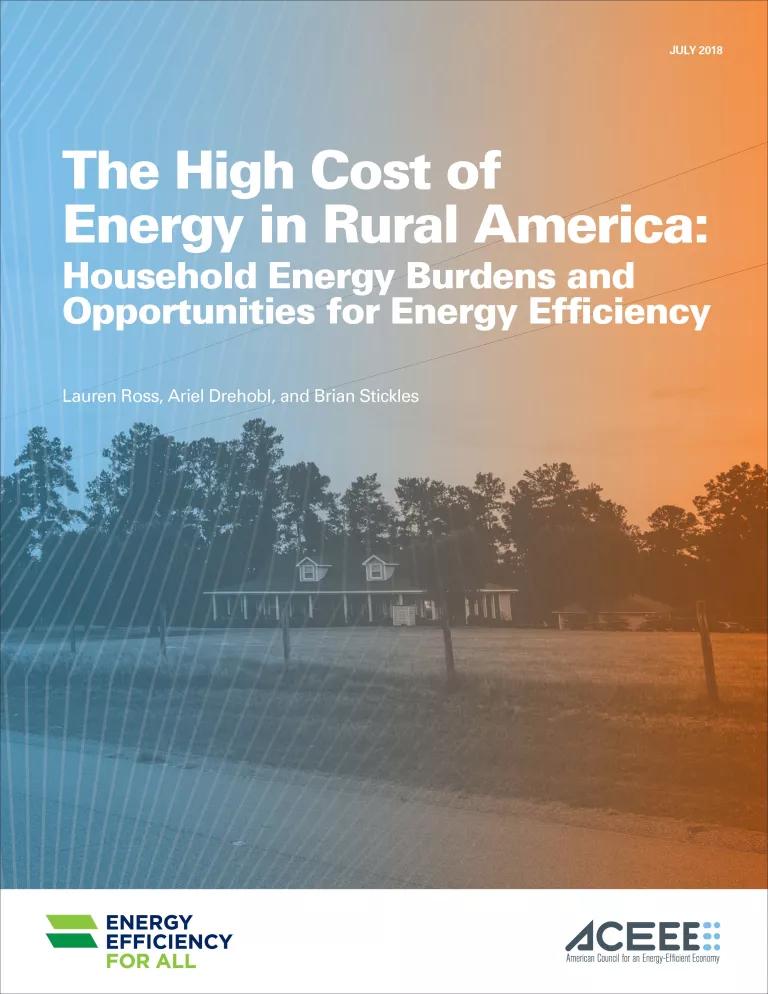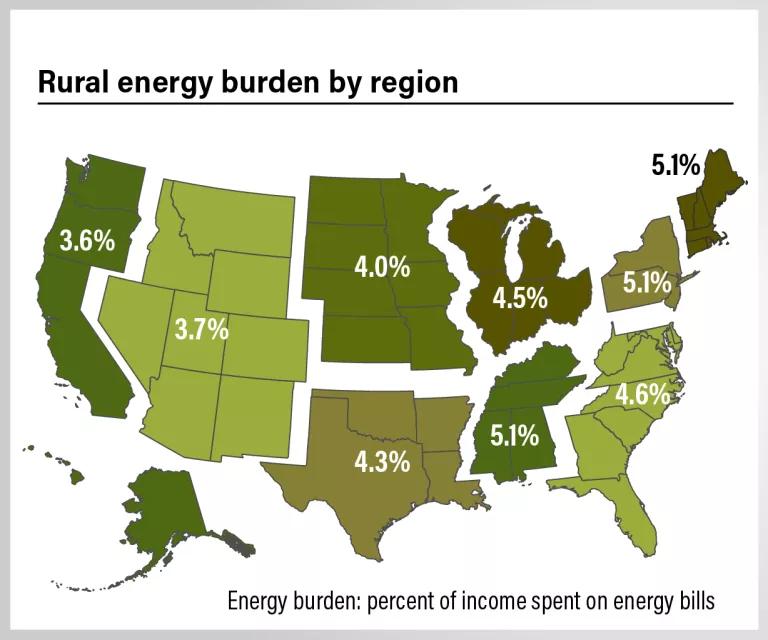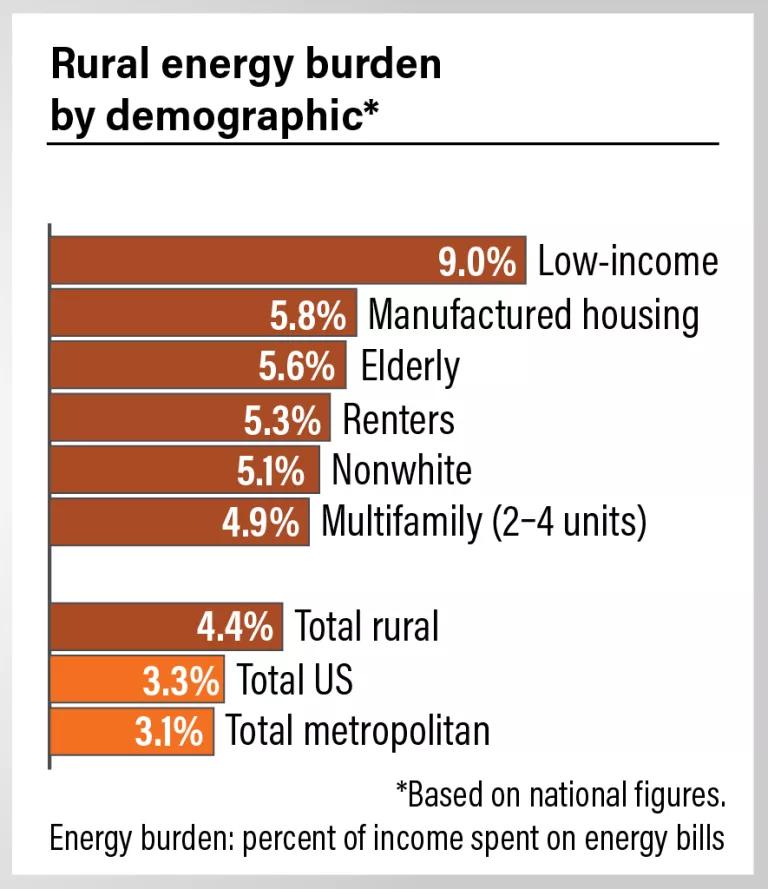Rural Families Overburdened with Higher Energy Costs
Rural families face the highest energy burdens of any household group in America and spend a much larger percentage of their income on energy bills than the average family, according to a new study published today by Energy Efficiency for All (EEFA) and the American Council for an Energy-Efficient Economy (ACEEE).

Rural families face the highest energy burdens of any household group in America and spend a much larger percentage of their income on energy bills than the average family, according to a new study published today by Energy Efficiency for All (EEFA) and the American Council for an Energy-Efficient Economy (ACEEE). The report, “The High Cost of Energy in Rural America: Household Energy Burdens and Opportunities for Energy Efficiency,” provides new evidence of the urgent need to expand energy efficiency programs to vulnerable communities in rural regions throughout the U.S.
The report is the first to focus on the energy burdens shouldered by those living in rural America. It builds on a previous report, Lifting the High Energy Burdens in America’s Largest Cities: How Energy Efficiency Can Improve Low-Income and Underserved Communities.
This report couldn’t come at a better time in a moment when the Trump administration’s Council of Economic Advisers released a report misreading and manipulating data to declare that the war on poverty has been a success. The administration’s aims are cynical at best and harmful to the wellbeing of many households and communities across the nation by punishing the poorest and most vulnerable. As this new report shows, poverty and deprivation not only persist but multidimensional and includes high energy burdens and increased vulnerability to utility shut offs. And it may be worsening in many of our bedrock communities and neighborhoods across rural and urban communities alike.
Overall, the rural energy burden report finds that while burdens vary greatly by region, rural households throughout the United States have a higher median energy burden (i.e., spend a higher percentage of household income on energy bills) than others in their overall region, as well as a higher burden compared with metropolitan households. Nationally, the median rural household energy burden is 4.4 percent, which is almost one-third higher than the national rate of 3.3 percent and about 42 percent above the median metropolitan energy burden of 3.1 percent. When looked at even more closely, the East South Central, New England, and Mid-Atlantic regions have the highest median rural energy burdens at 5.1 percent.

Rural Energy Burden by Region
In several regions including (the New England and Mid-Atlantic regions), one out of four low-income rural households have an energy burden greater than 18%. The report also finds that over a quarter of all rural low-income households devote more than 10% of their income to energy expenses. That’s a lot, and for a household it often means deciding between keeping heat or lights on vs paying rent, buying food or paying for medicines or school supplies. Such high energy burdens increases the likelihood that these households will see their utility services shut off at some point. Once shut off, additional fees increase the cost of reestablishing service, and inability to pay leads to arrears that damage credit ratings that make reopening services or even qualifying for better housing difficult or impossible.
Energy efficiency upgrades such as adding insulation and sealing air leaks can lessen these energy burdens by as much as 25 percent, resulting in more than $400 in energy bill savings annually for some households. These improvements also make homes more comfortable and healthier. And more efficiency reduces the need for power plants to generate electricity from fossil fuels, cutting energy bill costs and avoiding climate-warming pollution for everyone.
Rural communities face unique barriers to accessing energy efficiency
According to the U.S. Department of Agriculture, rural households make up roughly 16 percent of all U.S. households and are spread across 72 percent of the nation’s land area, making rural housing stock much less dense than in urban and suburban areas. In this study, rural was defined by utilizing U.S. Department of Agriculture’s rural-urban commuting area codes to map those regions not located in a metropolitan census tract.
Due to the lower densities of the population over wider areas, the cost of delivering energy and energy efficiency services to rural households is on average higher than for their urban counterparts. Rural communities are more likely to be serviced by smaller rural coops or publicly owned utilities that may lack the capacity or resources to invest in comprehensive energy efficiency programs. As such, energy costs are vastly higher than the national averages and higher than in metro areas.
Because of the uneven build out of infrastructure, rural households often must rely on less efficient methods of accessing energy for critical needs. Further, the lower density in rural communities has meant that rural land and housing values tend to be lower, leaving limited options for financing regular home repairs and updates, allowing homes to deteriorate over time.
Rural families are also more likely to be impoverished. Approximately 43 percent of households in rural areas have incomes below 200 percent of the federal poverty level, increasing vulnerability to high energy burdens. Low incomes, high energy use, non-ownership status, and inefficient housing stock are some of the key drivers of high energy burdens, which can place significant financial stress on families and other households.
Finally, rural households are much more likely to live in manufactured housing than their urban counterparts. More popularly known as mobile homes—which are built in a factory, transported to a site on a flatbed truck, and installed on-site—manufactured housing tends to be less energy efficient and more costly to repair than traditional homes. About 20 percent of all rural households live in manufactured homes, making provision of energy efficiency services costlier and less likely to happen.
Uneven impact of high energy burdens in rural communities

Rural Energy Burden by Demographic
Within rural communities, some groups face even higher burdens than the overall rate for the region, making them most vulnerable to changes in energy costs, usage, and housing options. For example:
Low-income rural families experience the highest median energy burden at 9 percent, which is almost three times greater than the non-low income rural median of 3.1 percent. Some low-income households are even worse off: In several regions of our nation, fully one-quarter of the low-income rural households have a median energy burden greater than 18 percent.
Residents of rural manufactured housing experience a median energy burden that is 32 percent higher than the overall rural energy burden.
Residents of multifamily housing with 2–4 units have a median energy burden that is 20 percent higher than that of rural single-family households.
Rural renters experience a median energy burden 29 percent higher than that of owners.
Households of color in rural areas have energy burdens 19 percent higher than that of their white counterparts.
Elderly households have shown the most significant vulnerability with energy burdens 44 percent higher than that of non-elderly households.
Energy Efficiency and Weatherization Services Can Provide Multiple Benefits to Rural Communities
Rural communities can achieve multiple benefits from energy efficiency investments. Efficiency can help low-income rural households reduce energy burdens and increase available income for other necessities.
As this video below produced by EEFA and ACEEE shows, high energy burdens are not just abstract or technical issues, they impact real life decisions and living qualities for millions of Americans.
Weatherizing a home for families living at or below 200 percent of the federal poverty level—which is just over $12,000 for a single person household and $25,000 for a four-person household—saves an average single-family home $283 per year. A full retrofit of a rural household to be as efficient per square foot as its metropolitan counterpart would yield savings of $119 per year for those families. Households residing in rural manufactured homes would see savings of $458 per year; over one-quarter of their energy bill and a full 1.5 percent of their household income. Rural renting, low-income, elderly, and non-white families would all save over $100 per year if they had the same utility costs per square foot as the metropolitan median household.
As our report shows, we can support increasing energy efficiency of rural homes in several ways, including;
- Improving demographic data collection to better target and reach customers
- Aggregating and sharing training resources and workforce development across larger regions to ensure job demand and a capable contracting crew to meet service needs
- Share program administration costs and resources by partnering smaller co-ops with larger utilities
- Bundle funds through fuel-blind programs so a single energy efficiency program can address all end uses together
- Create specific programs to target mobile and manufactured homes
- Partner with local community, nonprofit, and religious organizations to address certain necessary expenses for efficiency upgrades
Don’t allow the Trump administration to increase burdens on poor families it doesn’t believe exist. Just a month ago, U.S. Ambassador to the United Nations Nikki Haley last month denounced a U.N. report saying 18.5 million Americans suffer extreme impoverishment as “misleading and politically motivated.” The administration and its allies are politically motivated to underestimate the levels of poverty and hardship faced by many Americans as a justification for their attempt to eliminate social safety net programs and initiatives these households rely upon.
By improving housing efficiency with the goal of reducing energy burdens, we can have an impact on a wider range of issues/ These “non-energy benefits” include improved health, increased job opportunities, and a better quality of life in rural communities. The benefits far outweigh the costs. This study shows it’s time to turn our attention to a more energy efficient rural America.
Note: ACEEE and EEFA will hold a webinar at 1:00 PM EDT on Wednesday, July 25, to discuss the high energy burdens faced by rural Americans as well as key findings from the report. Register here: https://attendee.gotowebinar.com/register/1224046005412835329



